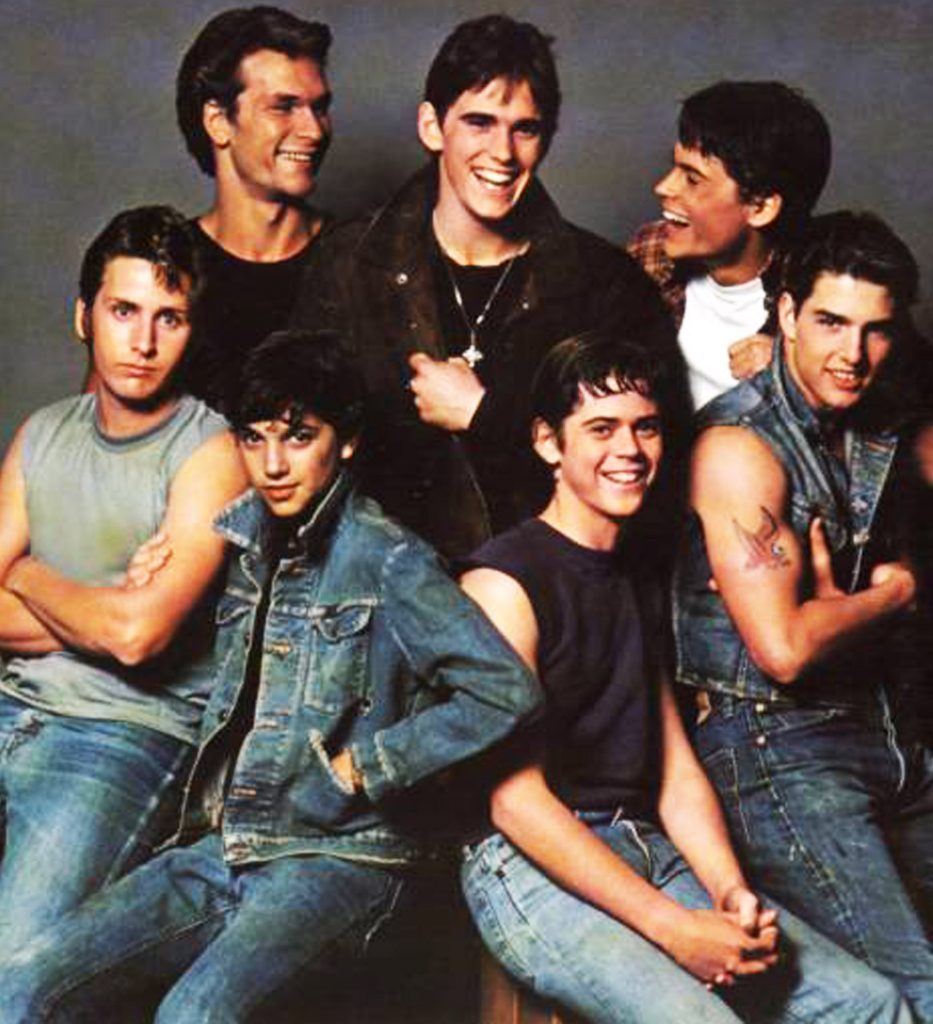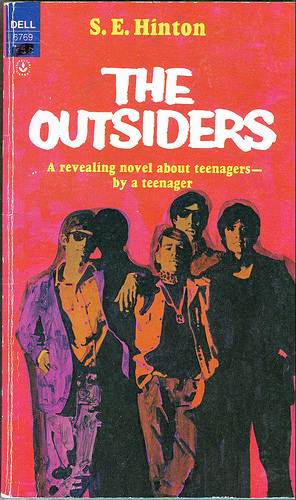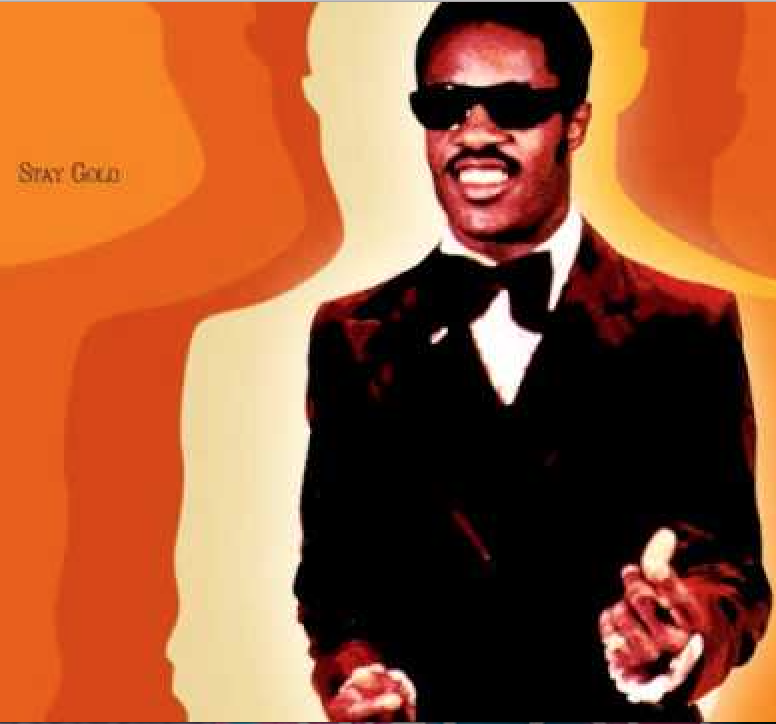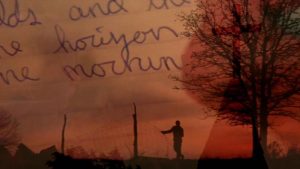 Like many growing up in the 1980s, I regarded “The Outsiders,” Frances Ford Coppola’s adaptation of S.E. Hinton’s 1967 young adult novel, as the ultimate babe fest. To date, it may be the greatest shrine to young male beauty ever filmed. Starring Rob Lowe, Matt Dillon, C. Thomas Howell, Ralph Macchio, Patrick Swayze, and Emilio Estevez at the apex of their hotness, a pre-orthodontia Tom Cruise was the ugliest dude in the cast. Turning flips in the air, popping perfect biceps in rolled-up black tees, lolling cigs out of rosy pouts, and batting long lashes beneath expertly combed pompadours, these boys were so appealing that they triggered early puberty in a whole generation of tweens (then called preteens).
Like many growing up in the 1980s, I regarded “The Outsiders,” Frances Ford Coppola’s adaptation of S.E. Hinton’s 1967 young adult novel, as the ultimate babe fest. To date, it may be the greatest shrine to young male beauty ever filmed. Starring Rob Lowe, Matt Dillon, C. Thomas Howell, Ralph Macchio, Patrick Swayze, and Emilio Estevez at the apex of their hotness, a pre-orthodontia Tom Cruise was the ugliest dude in the cast. Turning flips in the air, popping perfect biceps in rolled-up black tees, lolling cigs out of rosy pouts, and batting long lashes beneath expertly combed pompadours, these boys were so appealing that they triggered early puberty in a whole generation of tweens (then called preteens).
Thirty-odd years later, I dig this parade of Aphrodites even more, and for mostly loftier reasons. Howell stars as 14-year-old protagonist Ponyboy Curtis, so named by dead parents who left him in the care of 17-year-old brother Sodapop (Rob Lowe), a dreamboat of a high school dropout, and biggest brother Darrel (Patrick Swayze), who has forfeited his dreams of college to keep his younger siblings out of foster care. Based in Tulsa, Oklahoma, the Curtis boys live on the wrong side of the tracks – we’re reminded of this from the first scene’s lonely train whistle– and they provide a homebase for all the tenderhearted, rough-hewn “greasers” in their gang. There’s Steve (Cruise), Sodapop’s short fuse of a best friend. There’s Two-Bit (Estevez), who never works, never stops talking and drinking beer, and watches “Mickey Mouse” all day long. There’s Johnny (Macchio), a gentle boy whose parents are so brutal the other greasers feel protective of him. (I always wondered if his described “dark eyes and tan skin” were meant to signal Native American descent, given the story’s location.) And there’s Dallas (Matt Dillon), the hardest-hearted of the crew – a New York City transplant who’s already served time and is perpetually cruising for a bruising. He finds plenty of them from the Socs (short for “Socials”), Madras-clad rich kids whose chief hobby seems to be tormenting greasers. A sole exception is Cherry (Diane Lane), a Soc whom Ponyboy meets at the drive-in, but Bob (Leif Garrett), her alky Soc boyfriend, gets jealous with a vengeance that launches this story.
Though it did well at the box office, critics largely disparaged “The Outsiders,” perhaps because they were taken aback that the director of “The Godfather” films would lower himself to such seemingly trivial material. Young adult novels were considered far uglier stepchildren than they are today. I suspect the disdain also had to do with how the film valorized male love homoerotically if celibately. More than a bromance, it was an Indra’s Net of pretty boys with huge feelings, especially for each other. This called a lot of bluffs, especially in the 2005 director’s cut, which featured a scene in which Sodapop and Ponyboy cuddle in bed to comfort each other.
Coppola was intent on honoring Hinton’s story, so much so that he named his cut “The Complete Novel.” In turn she ardently honored the canons of literature and cinema. That most iconic line – “Stay gold, Ponyboy”–is a reference to Robert Frost’s “Nothing Gold Can Stay,” and it speaks volumes about the ecstasy of these influences. And then there’s that opening passage:
When I stepped out into the bright sunlight, from the darkness of the movie house, I had only two things on my mind: Paul Newman and a ride home …
Nothing could better summon the hard light greeting us when we emerge from the shared dreams of film and novels.
Hinton was only 15 when she began writing what was her first book, and she had to be cajoled into submitting it for publication. Presumably she, like Ponyboy, wrote it as therapy. Like the Curtis Boys, she grew up in a rough Tulsa, Oklahoma, neighborhood, and she was a self-proclaimed tomboy back when the term “tomboy” was not just a euphemism for young lesbians but for all girls rejecting the strict codes of ladylike behavior. Hinton has been married to a man for decades, not that it matters, and her love of masculinity seems as much a product of desire as a desire to embody it; the book is inspired by the Romantic poets as well as balder romantic fancies. Witness the novel Ponyboy and Johnny read while hiding from the cops: Margaret Mitchell’s soapy Gone With the Wind. Can you imagine if these boys were wrangling with Faulkner or Joyce?
 Whenever something is described as being “fifties,” I make the same joke: “Is it eighties fifties? Seventies fifties? Nineties fifties?” Each decade has its own take on that era when young people first expressed rebellion with an aesthetic entirely their own. Though “The Outsiders” is set in 1965, is is Hollywood fifties. The soundtrack is a mixture of Carmine Coppola’s swelling violins, Stevie Wonder crooning “Stay Gold” (be still my heart!), and “Gloria” by Them. Johnny feels like Sal Mineo of “Rebel Without a Cause”; with his twitching jaw and furious blinks, Dallas is as early Brando as they come. And the look of the film: Fuhgeddaboudit. Some didn’t dig the Hollywood sound stage visuals; I dug them mightily. With the starkness of navy, black, and white mediated only by sunset pastels, Coppola captured the inherent theatricality of adolescence–when the stakes are dramatic and melodramatic, when everyone feels so much that they long to be comfortably numb.
Whenever something is described as being “fifties,” I make the same joke: “Is it eighties fifties? Seventies fifties? Nineties fifties?” Each decade has its own take on that era when young people first expressed rebellion with an aesthetic entirely their own. Though “The Outsiders” is set in 1965, is is Hollywood fifties. The soundtrack is a mixture of Carmine Coppola’s swelling violins, Stevie Wonder crooning “Stay Gold” (be still my heart!), and “Gloria” by Them. Johnny feels like Sal Mineo of “Rebel Without a Cause”; with his twitching jaw and furious blinks, Dallas is as early Brando as they come. And the look of the film: Fuhgeddaboudit. Some didn’t dig the Hollywood sound stage visuals; I dug them mightily. With the starkness of navy, black, and white mediated only by sunset pastels, Coppola captured the inherent theatricality of adolescence–when the stakes are dramatic and melodramatic, when everyone feels so much that they long to be comfortably numb.
“I wanted to make a movie about youth and belonging,” the director has said about being convinced by a school librarian to adapt Hinton’s book. “Even though those boys were poor and, in a way, insignificant, the story gives them a kind of beauty and nobility.” Sure enough, Johnny and Ponyboy bathed in Nicholas Ray-style Cinemascope look like saints caught in stained glass.
Nearly all these young actors – handpicked in one of the most famous casting calls of all time – went on to brilliantly big careers, yet most clocked in their best performances here. It’s heartbreaking to watch steadfast Swayze, sweetly sad Lowe, and Dillon when he was all edge and no ham. It’s gratifying to watch Cruise simmering on the sidelines where he probably should have remained.
watch steadfast Swayze, sweetly sad Lowe, and Dillon when he was all edge and no ham. It’s gratifying to watch Cruise simmering on the sidelines where he probably should have remained.
Decades later, “The Outsiders” continues to worship at the altar of our imaginations. It is a paean to six packs and soft underbellies and male love and a rock-and-roll defiance of time, and it deserves to stay gold forever.
This was originally published at Signature.
